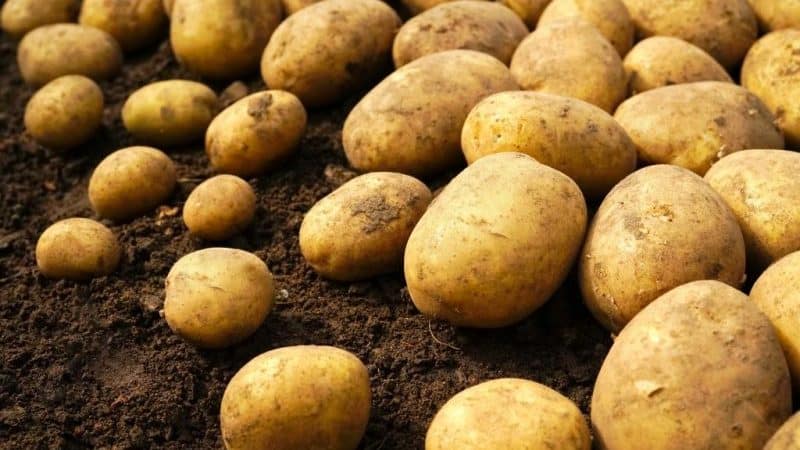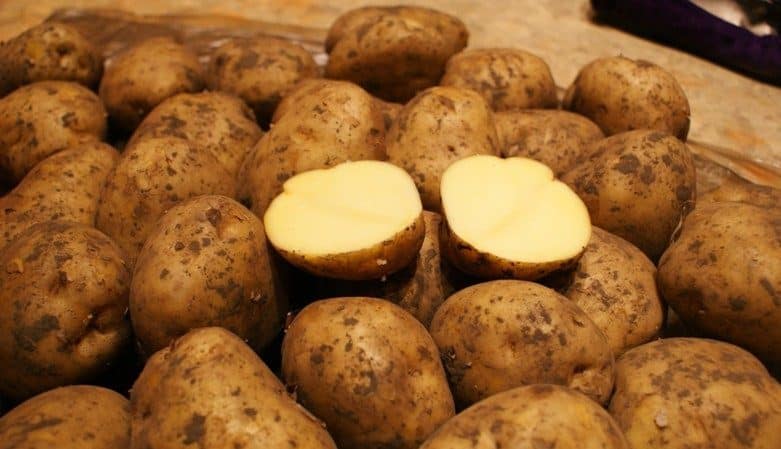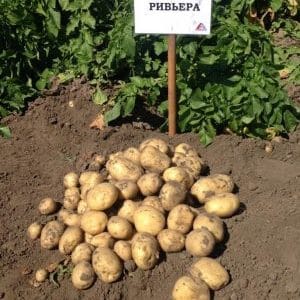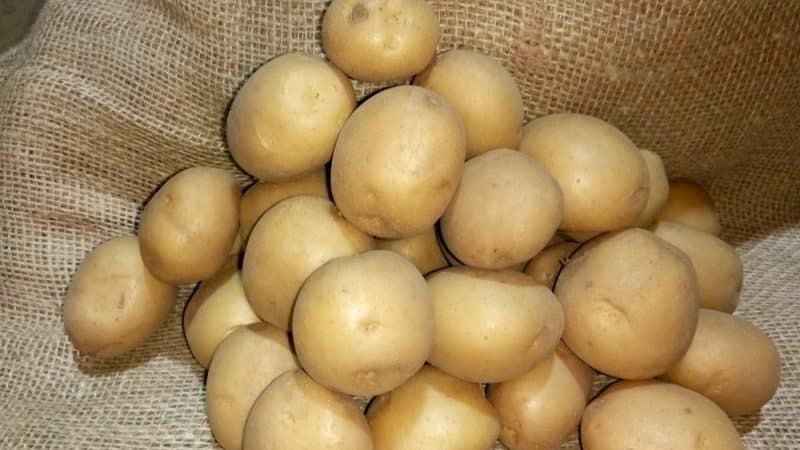Potato variety Riviera: grows in any climatic conditions
Breeders from different countries are constantly developing varieties that are more resistant to various diseases and environmental conditions, have excellent taste and produce rich harvests. This article will focus on the relatively new Dutch variety Riviera. You will learn how to prepare tubers, care for the plant, harvest and store crops, and fight diseases and pests.
Characteristics of Riviera potatoes
Riviera potatoes were bred by Dutch breeders in 2007. In 2013, it was included in the State Register of the Russian Federation.
The variety has taken root well in the central regions of Russia. It is successfully grown in Moldova and Ukraine. Riviera tolerates drought well and produces good harvests even in conditions of lack of moisture.

Chemical composition
Tubers contain the following nutrients:
- proteins - 2 g;
- fats - 0.4 g;
- carbohydrates - 18.1 g;
- water - 78.59 g;
- saturated fatty acids - 0.1 g;
- starch - 15 g;
- organic acids - 0.2 g.
Among the microelements are iron, iodine, zinc, copper, selenium, fluorine, vanadium, manganese, etc. Among the vitamins necessary to maintain the body in tone, proper metabolism, and strengthen the immune system are A, B, C, E, PP.
Calorie content product per 100 g is 77.2 kcal.
Characteristics of tubers and yield
Riviera has round and smooth tubers. The peel is yellow-brown, the flesh is light yellow.The height of the bushes is 85 cm, the stems are elastic, the leaves are large, dark green, the inflorescences are purple.
The variety has a powerful root system. From the moment the first shoots appear until full maturity, 45 days pass. The first tubers can be tasted 30 days after landings. The yield after 35 days is 280 c/ha, at the end of full ripening - 450 c/ha. One bush forms up to 14 tubers.
Difference from other varieties
Tubers contain 12-15% starch - less than other early ripening varieties. Seeds are prepared for planting in early April, a month before planting in open ground. The tubers have a beautiful appearance and wonderful taste. They store well in frosty weather. Riviera produces a harvest twice a year. The variety has the shortest ripening period and strong immunity to diseases.
The main advantages and disadvantages of the variety

Positive traits:
- delicious tubers;
- high-quality presentation;
- unpretentiousness;
- attractive appearance;
- immunity to dangerous diseases;
- early stages of ripening;
- two harvests per season;
- resistance to damage;
- keeps well in winter;
- is not damaged during transportation.
The disadvantage is the risk of late blight infection if harvested late.
Important! For planting, take even fruits weighing 80 g. Large tubers reduce the yield by half.
Features of planting and growing
To get a high yield, adhere to the following agricultural practices.
Preparing for landing
The field for planting is prepared in the fall, dug up, and fertilizers are added: 7 kg of humus, 40 g of potassium chloride, 60 g of superphosphate per 1 m². Soil with high acidity is alkalized with dolomite flour or 500 g of lime.
In spring, organic matter and minerals are added to the soil:
- 1 tbsp. ash;
- 1 tbsp. l. superphosphate;
- 1 tsp.potassium sulfate.
A month before planting, the tubers are germinated. They are scattered in a room where there is a lot of light and the temperature is +20°C. Turn the tubers periodically to ensure even sprouting. Before planting, they are etched with formalin at a dilution of 1:200 with the addition of copper sulfate - 2 g per 10 liters of water. The tubers are immersed in the solution for 5 hours.
Important! If the quantity of potatoes is small, cut it into 3 parts, each with at least 3 eyes.
Dates, scheme and rules of planting
Planted from mid-April or the first half of May at a temperature of +20°C. Potatoes are planted in an open area, well lit by the sun, in moist, heated soil to a depth of 10 cm using the traditional method.
- Mark the rows with twine.
- The distance between them is 70 cm.
- The depth of the holes is 20 cm.
- Pre-treated tubers are placed in them with their sprouts facing up.
- The interval between adjacent potatoes is 40 cm.
- Cover with soil in a layer of 6-10 cm.
- 40 tubers are planted on an area of 100 m².
Features of cultivation
When grown, the variety does not require frequent watering - only in severe drought. Riviera loves loamy, peaty, sandy loam soils containing nitrogen and potassium.
Reference! In spring and autumn the soil is dug up twice. As a result, productivity increases.
Nuances of care
Be sure to loosen the soil to ensure a flow of oxygen to the roots for the formation of good tubers. To prevent the roots from being exposed, the bushes are hilled twice during growth: when the tops reach 14-17 cm and before flowering.
The procedure is recommended to be carried out in the morning or evening, the soil should be moist. If you do not hill up, the yield loss will be 30%.
Another necessary procedure is weeding, which takes nutrients from the soil.
Watering mode
Water the Riviera only during severe drought. Water is poured under the bush in a jug so as not to wash away the root system. Watering from a hose is not advisable. Two weeks after emergence and at the budding stage, 3 liters per bush will be needed. Do not water in rainy weather.
Sprinkler irrigation is used on large fields. It moisturizes the soil and washes away insect pests from the tops.
Top dressing
Potatoes are fed when forming a bush:
- mineral fertilizers - 20 g of superphosphate, 10 g of urea, 10 g of sodium chloride per 1 m²;
- organic fertilizers - bird droppings are diluted with 2 liters of water in a ratio of 1:2.
Dry fertilizers are poured into the furrows at a distance of 12 cm from the row, the solutions are poured under each bush. It is important not to overfeed the plant, otherwise it will get sick.
Disease and pest control
The variety is resistant, withstands attacks from viruses and bacteria, but is not immune to fungal infections. The main diseases affecting the Riviera:
- Late blight - dark spots appear on the stems and leaves, the tops dry out. The pulp becomes inedible. The tops and soil around the bushes are sprayed with a solution of Fitosporin or 1% Bordeaux mixture 4 times per season. Interval - 10 days.
- Blackleg - leaves turn yellow, curl, dry out, roots rot. The bush is dug up and disposed of, 1 tsp is poured into the hole. vitriol and a glass of ash.
- Macrosporiasis - the leaf becomes sick, then the stems, gray-brown spots appear on them, the tops dry out, crumble and die. The plant gets sick at high humidity. Excess water is removed from the bushes by making drainage grooves. Treat with the drug “Growth-II” - 34 g per liter of water 2-3 times with a break of 2 weeks.
- Dry rot - Tubers become sick if stored improperly.They change color, become covered with dark spots, wrinkle, and empty holes form inside the potatoes. Such tubers must be destroyed.
When growing Riviera, you have to repel pest attacks:
- Colorado potato beetle - gnaws leaves to the ground. The plant is sprayed twice with a urea solution of 1 g per 10 liters. An adult specimen is collected by hand into a container with salt water.
- Medvedki — the bushes wither, holes appear in the ground. Tubers are saved with the drug “Medvetox”. It is applied to a depth of 5 cm (2 g per 1 m²) or the area is treated with the Nemabakt biological product. Once is enough.
- Wireworm - forms potato tunnels, the fruits begin to rot. The branches of the plant are sprayed with Karate - 2 ml per 10 liters of water. The treatment is carried out twice.
- Potato scoop - gnaws root stems and tubers. Treat with Fitoverm - 4 ml per 2 liters of water 3 times.
Harvest and storage

The crop is harvested at the end of June - beginning of July, the second time - in September. The potatoes are sorted, the seed material is laid out in a sunny place for greening.
The dug up tubers are dried in the boundary or under a canopy. They sort through and throw away rotten and diseased potatoes. Healthy tubers are placed in containers and taken away for storage in a dry basement.
Storage features and shelf life
The walls of the basement where the potatoes will be stored and the tubers themselves are sprayed with Anti-Rot. Thanks to this, keeping quality increases. The inside of the cellar is whitewashed with lime. Tubers are treated with a solution of copper sulfate - 0.1 g per 8 liters of water. Temperature range: +2…+4°C. During the winter, potatoes are sorted 2-3 times.
Root vegetables are stored in:
- basements, in bulk;
- wooden lattice boxes;
- containers with holes;
- bags, nets.
The tubers are covered with spruce branches and wormwood. This prevents fruit rotting. Precautionary measures will allow you to save 94% of the harvest without loss until spring.
What difficulties may there be when growing
Gardeners are faced with late blight and other diseases, and the invasion of insect pests. Failure to comply with agrotechnical rules will lead to tuber diseases. All of these factors affect their shape, size, structure and reduce productivity.
Gardener tips and reviews about the Riviera variety
Here are some tips from experienced gardeners:
- Do not plant the variety on heavy rocky soils - the tubers are deformed and grow slowly.
- The risk of late blight will be reduced if you plant onions and garlic next to potatoes.
- Do not grow the crop in one place for more than 3-4 years, the tubers become small.
- Potatoes grow well after cucumbers, onions, melons, and legumes.
- Gardeners recommend planting beans, coriander, tansy, and nasturtium in the rows to repel the Colorado potato beetle.
Most reviews of Riviera potatoes are positive.
Alexander, Crimea: «Riviera is a potato variety that everyone will like. Gives two harvests of marketable potatoes. Responsive to fertilizers. It grows in unfavorable regions and will withstand any drought. It keeps well, is large, can withstand transportation without loss, the tubers are tasty and beautiful in appearance. Profitable for sale. The Riviera potato variety fully corresponds to the description and photo.”
Victoria Mikhailovna, Khabarovsk region: “Different varieties of potatoes were planted for many years, and a small number of tubers were collected. The soil is just clay. Two years ago they proposed planting Riviera. We got a good harvest.From half a bucket of seeds they collected a bag of large fruits of the same size. The next year they planted their own seeds. With Riviera the harvest is guaranteed!”
Valentin, Suzdal: “We have been growing this variety for three years in a row. Stable yield, stable immunity. Does not require special knowledge, everything is traditional. Delicious, not is overcooked, doesn't get dark. Last year, various varieties were planted, but the fruits suffered from late blight. Riviera did not get sick, the foliage remained green until harvesting. We reaped a decent harvest."
Read also:
Medium-early, unpretentious potato variety "Red Fantasy".
Galaxy potato variety with excellent taste and long shelf life.
The Lasunok potato variety is loved by farmers for its ease of care and productivity.
Conclusion
The Dutch Riviera variety attracts gardeners and farmers with its high yield, early ripening, wonderful taste, and unpretentiousness to environmental conditions. Even in severe drought, the Riviera will not leave its owners without a harvest. Proper care of potatoes will give an increase in tubers, which is what every gardener dreams of!